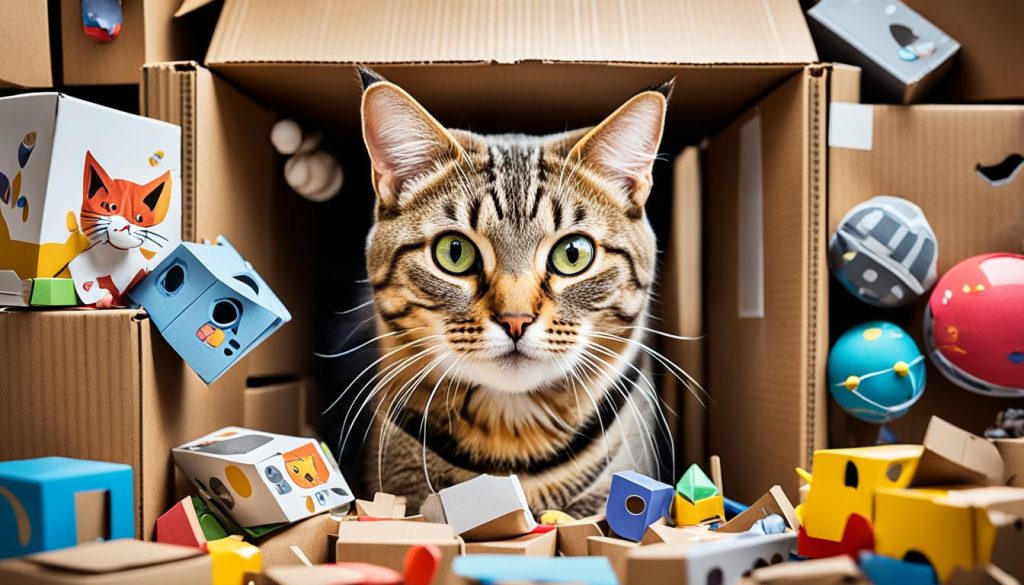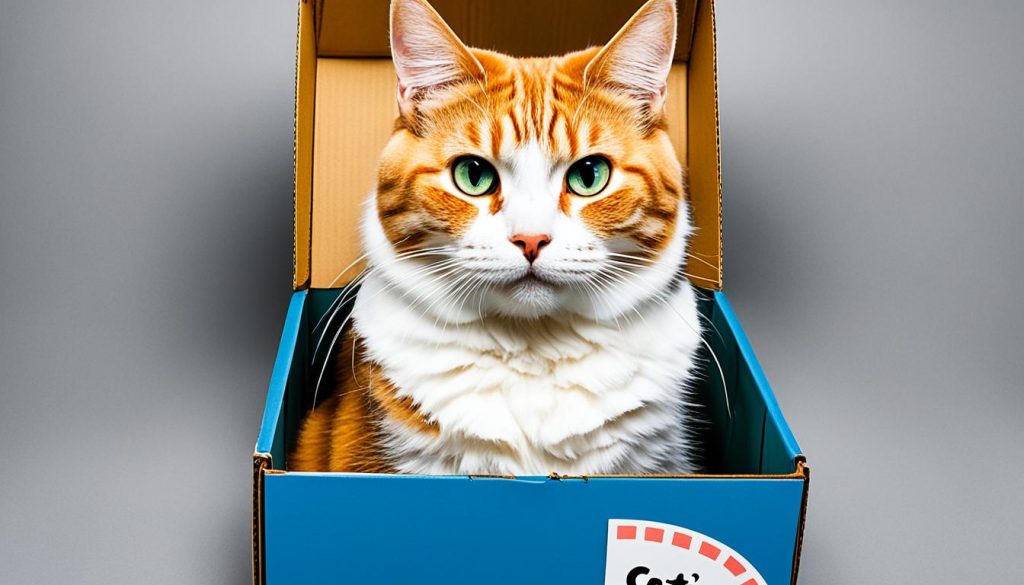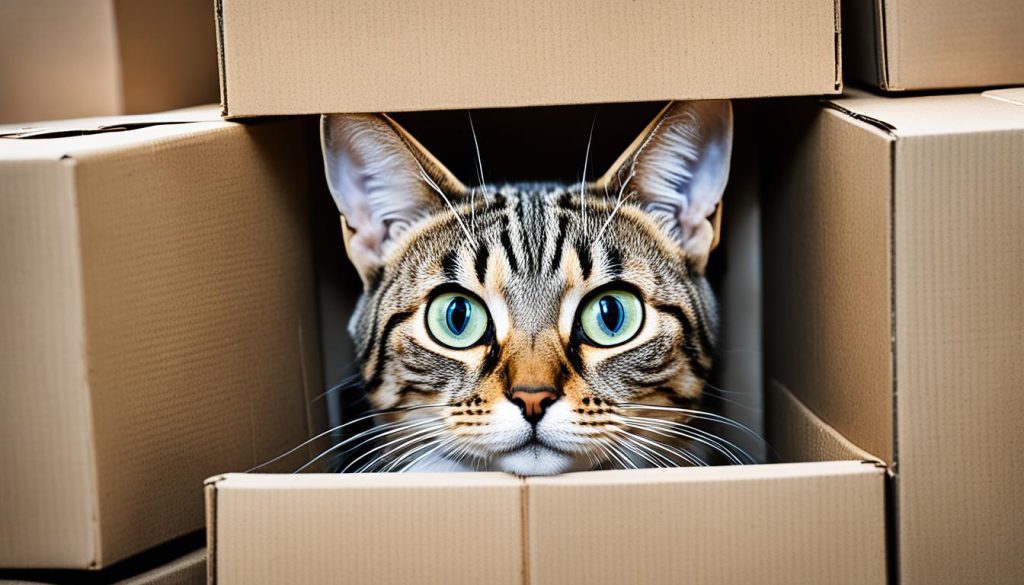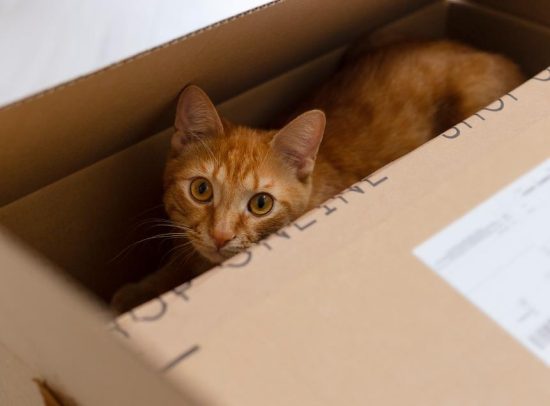Why Do Cats Like Boxes? The Surprising Reasons
Discover the fascinating science behind your cat’s box obsession. Learn why do cats like boxes and what comfort and joy they find in them.

Did you know that 90% of cats are strongly attracted to boxes? It’s true! Regarding cats and their fascination with boxes, there’s more to it than meets the eye. While we may find it amusing or even perplexing, there are scientific reasons behind this feline obsession. Understanding why cats love boxes can provide valuable insights into their behavior and how we can enhance their well-being.
In this blog, we’ll explore the psychology of cats and the interplay between their natural instincts, need for security, and the allure of boxes. From their primal hunting instincts to the comfort and warmth boxes offer, we’ll unlock the secrets behind this intriguing phenomenon. So, if you’ve ever wondered why your furry friend goes crazy for an empty cardboard box, look no further—we’ve got you covered.
The Psychology Behind the Box
Cats are natural ambush predators, and their fascination with boxes can be traced back to their instinctual behaviors. The confined space of a box mimics the environment of a hunting ground, where cats can hide and wait for their prey. This offers them a sense of security and taps into their innate instincts as ambush predators.
Moreover, the interplay between curiosity and caution drives cats to explore boxes. Cats are naturally curious creatures, and they are drawn to anything new in their environment. Their cautious nature prompts them to approach unfamiliar objects with a sense of intrigue and careful observation. Boxes provide a perfect outlet for their curiosity, allowing them to investigate and interact with the unknown.
The texture of cardboard also enhances a cat’s hunting instincts. The rough surface of the material provides resistance when scratched, similar to the feeling of hunting prey. This tactile stimulation triggers their hunting instincts, making the box not only a hiding spot but also a source of entertainment and mental stimulation.
Understanding the psychology behind cats and boxes helps explain why this seemingly odd behavior is so prevalent among our feline friends. By incorporating boxes into their environment, we can provide them with a stimulating and engaging space that aligns with their natural instincts.

Comfort and Security in Cardboard Castles
Cats seek comfort and security in enclosed spaces, and cardboard boxes provide the perfect hideaway for them. The confined nature of a box helps reduce stress and creates a safe haven where cats can find solace. Inside the cozy walls of their cardboard castle, cats can observe their surroundings without being seen, fulfilling their instinctual need to remain hidden from potential threats.
For cats, boxes offer more than just a place to rest or play. They serve as a source of comfort and security that taps into their natural instincts. Whether it’s a small shoebox or a larger shipping box, these humble cardboard structures become safe zones where cats can retreat and unwind, away from the world’s demands.
Additionally, boxes provide an optimal vantage point for cats to maintain vigilance over their territory. From the elevated position inside a box, they can keep a watchful eye on their surroundings, ready to spot any potential intruders. This heightened sense of awareness and the feeling of being in control further contribute to the comfort and security that boxes offer cats.

While it may seem strange to us humans, cats find comfort, joy, and a sense of ownership in the simplicity of a cardboard box. These humble structures transform into their private kingdoms, fulfilling their instinctual desires and providing them with the security and peace they need.
The Cozy and Warm Appeal of a Box
When it comes to finding a cozy and warm retreat, cats have a natural knack for seeking out the most inviting spots. And what could be more inviting than a box? Boxes offer our feline friends an insulating retreat from the chilly temperatures, providing them with a snug and comforting environment.
The magic behind the cozy appeal of a box lies in its construction. The cardboard material acts as a fantastic insulator, trapping heat within its walls and creating a warm microclimate for cats to curl up in. This makes boxes particularly enticing for cats, especially during colder seasons or in homes with colder rooms.
Unlike humans, cats have a higher thermoneutral zone, meaning they prefer warmer temperatures than we do. Boxes help cats regulate their body temperature within their preferred range, making them feel comfortable and content. They can simply nestle into the box, surrounded by the warmth it provides, and enjoy a restful nap or snooze. Whether it’s seeking solace from a chilly breeze or finding the perfect spot to snuggle up, cats are instinctively drawn to the cozy and warm appeal of a box. It’s like their very own personal sanctuary, tailored to their feline temperatures and providing the ultimate level of comfort.
Territorial Marking and the Scent of Ownership
One fascinating aspect of cats and their love for boxes is their natural instinct for territorial marking. Cats have scent glands on their paws, and when they scratch and rub against a box, they are leaving their signature scent as a form of territorial ownership. This behavior allows them to establish their presence and communicate with other cats in their environment.
The cardboard material of the box also serves a dual purpose. Not only does it provide a satisfying texture for scratching, but it can also act as a phantom scratching post. Cats have an innate need to scratch and mark their territory, and the rough texture of the cardboard fulfills this instinct in a satisfying way. It effectively becomes a substitute scratching post, further enhancing the appeal of boxes for cats.
The Irresistible Lure of Textures and Sounds
Cats are naturally attracted to the lure of textures and sounds that come with boxes. One aspect that captivates them is the captivating corrugation of cardboard material. Corrugated cardboard provides a unique texture that cats find appealing. They enjoy scratching and kneading on the rough surface, which satisfies their instinctual urge to sharpen their claws and mark their territory.
The experience of playing with boxes is not just a tactile one for cats; it also offers auditory delights. When cats interact with cardboard, the material produces a distinct crinkling sound that captures their attention. The sound of crinkling cardboard enhances their playtime, making it more engaging and stimulating. It adds an extra level of excitement to their exploration and play sessions.
The lure of textures and sounds associated with boxes makes them irresistible to cats. They are drawn to the captivating corrugation and the auditory delights of crinkling cardboard. These sensory experiences tap into their natural curiosity and provide them with sensory stimulation, enhancing their playtime and overall enjoyment.
Why Do Cats Like Boxes – Unpacking the Attraction
By unpacking the various reasons behind why do cats like boxes explanation, we can gain a better understanding of this feline attraction. Cats’ love for boxes can be traced back to their instinctual behaviors and preferences.
One of the primary reasons behind cats loving boxes is the feeling of safety and security it provides. Boxes create enclosed spaces that mimic the protection cats seek in the wild. The confined environment offers a sense of comfort and a place to hide from potential threats. Additionally, boxes tap into cats’ natural curiosity. Curiosity and caution go hand in hand for cats, and the presence of a box triggers their exploration instincts. The unknown within the box, whether it’s a hidden toy or an unfamiliar scent, sparks their curiosity and drives them to investigate further.
Boxes also provide cats with sensory stimulation. The corrugated texture of cardboard boxes offers a satisfying scratching surface for cats. It serves as an alternative to scratching posts and satisfies their natural need to scratch and stretch their claws. Furthermore, the warmth and coziness of boxes make them an attractive spot for cats to rest and sleep. Cardboard acts as an insulator, trapping their body heat and providing a snug sleeping environment, especially during colder temperatures.
Finally, boxes allow cats to mark their territory. Cats have scent glands on their paws, and by rubbing or scratching against a box, they leave behind their signature scent. This territorial marking behavior is a way for cats to establish ownership and communicate with other cats in their environment. Exploring these various reasons helps unravel the mystery behind why cats are so enamored with boxes. From their instinctual behaviors to the sensory experiences and feelings of safety and security, boxes provide a multitude of benefits that resonate with cats’ natural inclinations.
Curbing the Cardboard Carnage: When Chewing Becomes Obsessive

While cats’ fascination with boxes is generally harmless, it’s important to address excessive chewing on cardboard, which can become a concern. This section explores the line between normal play behavior and pica, a condition where cats compulsively chew on non-food objects. Understanding the distinction between the two can help cat owners identify potential issues and take appropriate measures to curb the behavior.
The Line Between Play and Pica
Play is a natural behavior for cats, and engaging with boxes can provide mental and physical stimulation. However, when the play behavior escalates into pica, it may indicate underlying health or behavioral issues. Pica is characterized by the persistent craving and ingestion of non-edible substances, such as cardboard or other materials. If your cat’s chewing behavior extends beyond play and becomes obsessive or compulsive, it’s essential to consult a veterinarian to rule out any medical conditions.
Dental Indicators and Box Biting
Box biting can be a sign of dental problems in cats. Chewing on cardboard or other objects may provide relief for cats experiencing dental pain, discomfort, or inflammation. If your cat shows a preference for biting on cardboard boxes, it’s advisable to have their dental health evaluated by a veterinarian. Dental issues can contribute to chewing behaviors and may require dental treatment to alleviate any underlying problems.
In addition, while chewing on cardboard boxes might seem harmless, it’s essential to monitor your cat’s behavior to ensure they are not ingesting dangerous materials or swallowing large pieces of cardboard that can cause gastrointestinal blockages. Providing safe and appropriate chewing alternatives, such as cat-friendly toys or dental treats, can help redirect their chewing behavior and protect their well-being.
From Practicality to Playtime: The Multipurpose Box
Aside from providing comfort and security, boxes have proven to be incredibly practical and multipurpose items for cats. They go beyond being mere containers and transform into personal playgrounds that cater to their innate instincts and playful nature. The practicality of boxes lies in their ability to serve multiple functions, making them an essential addition to a cat’s environment.
A Personal Playground
When a box is introduced into a cat’s territory, it becomes an inviting space for exploration and play. The empty box transforms into a haven that encourages cats to engage in their natural behaviors. It becomes a blank canvas, allowing them to jump, hide, and pounce freely. Cats find immense joy in squeezing themselves into snug spaces and popping out unexpectedly, turning the box into their own personal playground.
Interactive Entertainment Center
Boxes are not just limited to solo playtime for cats. They also offer opportunities for interactive entertainment, both for the cats themselves and for their owners to bond with them. Cats enjoy playing peek-a-boo when their owners interact with them through box openings, adding an element of surprise and excitement to their play sessions.
Owners can also enhance the interactive experience by placing toys or treats inside the box, enticing cats to engage with the box even more. This not only stimulates their natural curiosity but also strengthens the bond between cats and their human companions. The interactive nature of boxes allows for shared moments of joy and entertainment, creating lasting memories for both cats and their owners.
FAQs on Why do cats like boxes
What does it mean when cats love boxes?
Cats’ love for boxes is rooted in their natural behaviors and instincts. It signifies their need for security and comfort in enclosed spaces, as well as their territorial marking and communication habits. Boxes also provide warmth and a cozy retreat for cats.
Why are cats obsessed with boxes?
Cats’ obsession with boxes is a result of their instinctual behaviors and preferences. Boxes offer the perfect hiding place where cats can feel safe while still observing their surroundings. The confined space of a box provides the thrill of hunting and appeals to their natural curiosity.
Why do cats like to chew on cardboard?
Cats may chew on cardboard due to their innate need to scratch and groom. The texture of cardboard provides satisfaction for their scratching and helps keep their claws in good condition. Chewing on cardboard can also serve as a form of play, mental stimulation, and teeth cleaning.
Why do cats like squares so much?
Cats are attracted to squares, including boxes, because they provide them with security, warmth, and a sense of territory. The shape of a square or box offers defined boundaries and enhances their comfort and relaxation. Additionally, squares provide stability, making them ideal for perching and observation.
What is the science behind cats in boxes?
The science behind cats in boxes revolves around their natural instincts and behaviors. Boxes offer a secure hiding place that mimics their preferred hunting environment. The texture and sound of cardboard engage their senses and provide mental and physical stimulation. Additionally, boxes allow cats to mark their territory and observe their surroundings without being seen.





